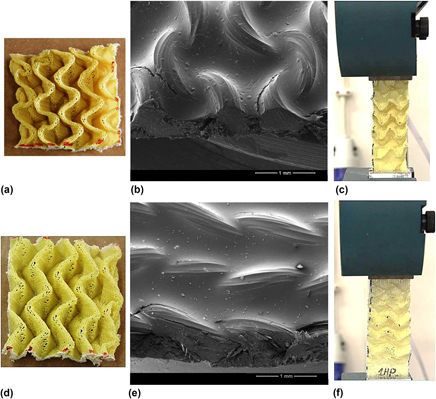Crossref Citations
This article has been cited by the following publications. This list is generated based on data provided by
Crossref.
Duncan, Olly
Shepherd, Todd
Moroney, Charlotte
Foster, Leon
Venkatraman, Praburaj D.
Winwood, Keith
Allen, Tom
and
Alderson, Andrew
2018.
Review of Auxetic Materials for Sports Applications: Expanding Options in Comfort and Protection.
Applied Sciences,
Vol. 8,
Issue. 6,
p.
941.
Cao, Haijian
Zulifqar, Adeel
Hua, Tao
and
Hu, Hong
2019.
Bi-stretch auxetic woven fabrics based on foldable geometry.
Textile Research Journal,
Vol. 89,
Issue. 13,
p.
2694.
Steffens, Fernanda
Gralha, Sharon Erckmann
Ferreira, Iêda Letícia S.
and
Oliveira, Fernando Ribeiro
2019.
Military Textiles - An Overview of New Developments.
Key Engineering Materials,
Vol. 812,
Issue. ,
p.
120.
Hu, Hong
Zhang, Minglonghai
and
Liu, Yanping
2019.
Auxetic Textiles.
p.
337.
Bessa, Poincyana S.
Ladchumanandasivan, Rasiah
Steffens, Fernanda
and
Oliveira, Fernando Ribeiro
2019.
Dyeing of Meta-Aramid Fibres Previously Functionalized with Poly(Diallyldimethylammonium Chloride).
Key Engineering Materials,
Vol. 812,
Issue. ,
p.
107.
Nallavan, G.
2020.
Impact of recent developments in fabrication of auxetic materials on safety and protection in sport.
Vol. 2271,
Issue. ,
p.
030006.
Steffens, Fernanda
Oliveira, Fernando Ribeiro
and
Fangueiro, Raul
2021.
Energy absorption from composite reinforced with high performance auxetic textile structure.
Journal of Composite Materials,
Vol. 55,
Issue. 7,
p.
1003.
Lai, Chang Quan
Markandan, Kalaimani
and
Lu, Zhen
2021.
Anomalous elastic response of a 3D anti - tetrachiral metamaterial.
International Journal of Mechanical Sciences,
Vol. 192,
Issue. ,
p.
106142.
Moshtaghian, Zahra
Hasani, Hossein
Zarrebini, Mohammad
and
Pourheidar Shirazi, Mohammad
2022.
Development and auxetic characterization of 3D composites produced with newly-designed multi-cell flat-knitted spacer fabrics.
Journal of Industrial Textiles,
Vol. 51,
Issue. 2_suppl,
p.
2010S.
Peng, Xiangfei
Cao, Xin
Wang, Yu
Dong, Yong
Li, Zhonghua
Xu, Hong
Liu, Bin
and
Bai, Peikang
2022.
Design, Microstructure, and Mechanical Property of Negative Poisson's Ratio Porous Structure Fabricated by Lpbf of Alcocrfeni2.1 Eutectic High-Entropy-Alloy.
SSRN Electronic Journal ,
Peng, Xiangfei
Cao, Xin
Wang, Yu
Dong, Yong
Li, Zhonghua
Xu, Hong
Liu, Bin
and
Bai, Peikang
2023.
Design, microstructure, and mechanical property of negative Poisson's ratio porous structure fabricated by LPBF of AlCoCrFeNi2.1 eutectic high-entropy-alloy.
Journal of Materials Research and Technology,
Vol. 24,
Issue. ,
p.
2028.
Nguyễn, Hoa
Fangueiro, Raúl
Ferreira, Fernando
and
Nguyễn, Quyền
2023.
Auxetic materials and structures for potential defense applications: An overview and recent developments.
Textile Research Journal,
Vol. 93,
Issue. 23-24,
p.
5268.
Moshtaghian, Zahra
Hasani, Hossein
and
Zarrebini, Mohammad
2023.
A simulation approach to auxetic and non-auxetic behavior of 3D composites produced with multi-cell flat-knitted spacer fabrics.
The Journal of The Textile Institute,
p.
1.
Yang, Tong
Ma, Yuntong
Liu, Shuai
Peng, Huitao
and
Ma, Pibo
2023.
Characterization of negative Poisson’s ratio of two/three dimensional auxetic knitted fabric with PET/PA/cotton from folded structures.
The Journal of The Textile Institute,
p.
1.
Jiang, Lili
and
Ishaq, Samina
2024.
Handbook of Stretchable and Elastomeric Textiles.
p.
125.
Mohmmed, Ramadan
Osman, Nada
Gu, Bohong
Mohamed Ahmed, Hasabo Abdelbagi
and
Trabzon, Levent
2025.
Negative Poisson’s ratio weft knitted continuous filament PP fabric/epoxy resin composites with different loop lengths under impact loading.
The Journal of The Textile Institute,
p.
1.
